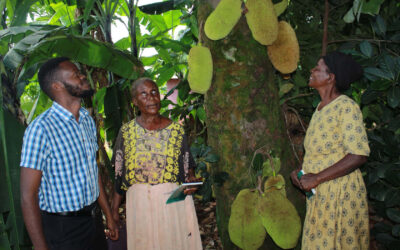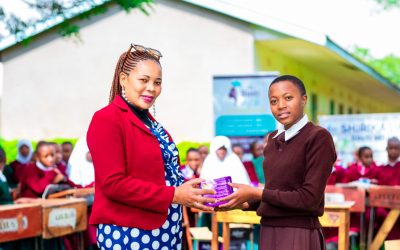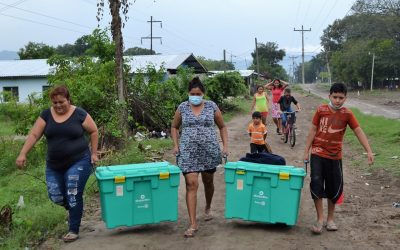The new face of Rotary “Down Under”
Rotary in Australia is like the country itself — big and diverse. Australia is the most successful multicultural society in the world.
Almost half of today’s population was either born abroad or has at least one foreign-born parent.
Most Australian Rotary clubs have also embraced Rotary International’s diversity, equality, and inclusion policies with enthusiasm, welcoming many different people into their communities.
While Australia’s oldest clubs, celebrating their 100th anniversary this year, could still be considered elitist – affluent and clinging to traditional lunch meetings with a traditional meeting format – clubs gather from small country towns to coastal communities in a variety of different forms.
In Queensland’s capital, Brisbane, the Rotary Club of Woolloongabba is the first Rotary club in the world to sponsor a Pride Club in support of the state’s LGBTIQ community. RC Woolloongabba has been supporting LGBTIQ organisations such as the Queensland Council for LGBTI Health and Open Doors Youth Service for several years.
Last year, club members formed the first Rotaract Pride Club, a first for Rotary International.
District 9640 is the district with the best results in membership growth and retention in Zone 8 and has redefined the boundaries of club development.
Then-Governor Andy Rajapakse and his team formed five new Rotary clubs, two Rotary satellite clubs, three Rotaract clubs, an Interact Club, and a Rotex Club.
“We have added a record number of 383 new members to our 58 Rotary clubs in 365 days,” said Andy Rajapakse. “63% of them were female and 24% were under 40. The Gold Coast Passport Rotary Club and the Gold Coast Corporate Rotary Club are among the district’s best innovations.”
At the national level, to celebrate Rotary’s 100th anniversary, clubs and districts from across the zone have come together “Down Under” (Australia, New Zealand, and south-west Pacific) to support the Rotary100downunder, Rotary Give Every Child a Future initiative.
The project celebrates 100 years of service and, in collaboration with Unicef, will vaccinate 100,000 children in nine South Pacific island countries against rotavirus, pneumococci and cervical cancer over three years.
Working with Unicef, Rotary will work with local governments to develop and implement vaccination programs that administer the vaccines. By strengthening health systems in the Pacific, the sustainable delivery of these vaccines will continue to be ensured in the future.
Although there are many centenary projects throughout the zone this year, Rotary Give Every Child a Future is the project that involves all of Australasia and shows that Rotary remains strong in today’s world.
Meagan Martin: (Gold Coast Passport Rotary Club) has been editor of Rotary Down Under since 2019.
Every 300th Norwegian is a Rotarian
Six years before former Chancellor and Hapag CEO, Wilhelm Cuno, founded the Rotary Club of Hamburg, the first Rotary club in Germany, the first club in Scandinavia had been founded on October 13th, 1921.
Olaf M. Oleson, a Norwegian-American Senator from Idaho and member of the Rotary Club of Fort Dodge, had attended the Rotary International Convention in Edinburgh in June 1921.
He then visited his native country and told his nephew about Rotary.
Ola Five, captain of the Royal Guard, gathered eight friends and founded the Rotary Club of Kristiania. In 1924, like the city, the club changed its name and has since been called Oslo Rotary Klubb.
Among the honorary members is Crown Prince Haakon Magnus. His father, King Harald V, is honorary governor of the seven Norwegian Rotary districts.


Rotarian Bjørn Rismyhr makes Rotary visible with his desired license plate.
The Oslo Rotary Klubb has not only founded 19 clubs in Norway, but it was also the godfather of the Stockholm Rotary Klubb with the København Rotary Klubb.
Today, Norway is one of the Rotary strongholds with 335 clubs and around 14,000 members – every 300th Norwegian is a Rotarian.
The Rotary Club of Melhus has had a limited edition gold ring found during an archaeological excavation reproduced and sells it with a non-profit goal for 3000 or 2500 euros.
The clubs open their encounters at each meeting with a “Gladmelding”, offering personal good news.
Meanwhile, a member goes from table to table and sells lots; the winner will receive wine, the winner will be drawn by the speaker of the day. The proceeds benefit the club treasury.
Since southern Africa is a region where there is so much inequality and poverty, there are many needs. I can safely say that all seven priority areas are very relevant for Southern Africa.”
In a three-minute lecture, a member comments on a current topic before a cold ‘lunsj’ is served at lunchtime meetings and a warm ‘middag’ in the evening.
Thanks to the excellent digital infrastructure, the clubs implement a variety of web-based initiatives.


The RC Melhus has had a limited edition gold ring found during an archaeological excavation reproduced and sells it with a charitable goal for 3000 or 2500 euros.
One of them is the digital melting pot. In regular network meetings, the clubs at regional and national levels co-ordinate existing and planned projects, pool resources and thus increase the
benefits of Rotary project work.
The Rotary Club of Færder focuses on academic youth. It offers returning exchange students free membership.
Bjørn Rismyhr (RC Karmøy-Vest) had his Mercedes marked “Rotary” with a personal licence plate. “Rotary, is this a dance club?” was one of the questions he heard. “Whatever people ask, it’s a good opportunity to introduce Rotary,” says Rismyhr.
Kai-Axel Aanderud (RC Hamburg-Deichtor) is the son of a Norwegian father and a German mother.
Inequality and many needs
There are three districts (9350, 9370 and 9400) that span South Africa and geographically include six neighbouring countries, namely Angola, Botswana, the Kingdom of Eswatini, Lesotho, southern Mozambique and Namibia.
Visiting a city club can be very different from that of a club in the countryside. The members of city clubs are traditionally executives from industry and more formal.
In the past, the clubs in the countryside mainly attracted members of medium-sized and small companies, which are very sociable and less formal.
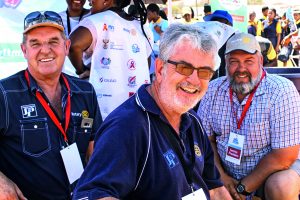

At Rotary Family Health Days, more than eleven million free health services have been provided to more than 2.5 million patients since 2011. Past-Gov. Grant Daly (centre) was also there.
However, both forms of clubs are constantly changing as they strive for diversity and gender equality. While women weren’t accepted into Rotary until 1991, we have a 32% share of female Rotarians.
At Rotary Family Health Days, more than 11 million free health services have been provided to more than 2.5 million patients since 2011.
Most clubs in southern Africa are based on the historical, traditional club model. The concept and flexibility of e-clubs and satellite clubs are slowly gaining traction.
The clubs are passionately committed to their projects. It’s always a very humble experience to see what the clubs do and the difference they make.
Since southern Africa is a region where there is so much inequality and poverty, there are many needs. I can safely say that all seven priority areas are very relevant for Southern Africa.
If I were forced to prioritise needs, I would list the following areas in order of importance: water and sanitation, malnutrition and early childhood development, economic opportunities, peace, and conflict prevention.
The Southern African region is very receptive to inter-country committee agreements.
So far, there are good relations with districts in Germany, Canada, India and the United Kingdom. These relationships are built not only for projects but also for friendship exchanges, youth exchanges, cultural exchanges, conferences or webinars.
Grant Daly is a Past-Governor of District 9400.
Much less traditional than in Germany
Britain has always behaved like an unruly teenager in the past – proud but stubborn and very independent. After all, we are an island nation that is only 20 miles from the European mainland at its narrowest point.
But in the context of Rotary in Britain and Ireland, the nations of England, Scotland, Wales, Northern Ireland, and the Republic of Ireland are five countries and two very different islands in terms of their characteristics and cultures.
Yet we are all connected by Rotary’s common bond.
There are about 40,000 Rotarians in the UK and Ireland, reflecting a continuous decline in membership numbers in recent decades. Of these, 22% are female, and the average age is 71 years.
But these are not typical times. Covid-19 has changed the shape and nature of Rotary around the world. With clubs meeting online, the opportunities to raise funds are extremely limited.
Around 12.4 million Britons volunteered in their communities during the pandemic, plus tens of thousands in the Republic of Ireland. The challenge after the pandemic will be to welcome these future Rotarians into our clubs now that they
have a taste for volunteering.
Over the past 16 months, Rotary clubs have been engaged in their communities to help people in need and isolated people shop and pick up medicines.
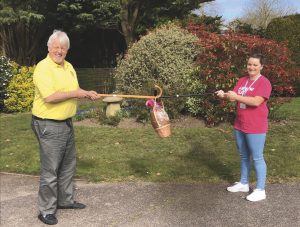

David King, past president of RC Colchester from Essex in the East of England, hands over Easter eggs to Sarah Raven-Lloyd of the Rainbow Trust, a charity that supports families of seriously ill children, due to the pandemic.
They have supported food banks, which exist under unbearable conditions due to rising unemployment.
Clubs have worked together in teams to provide personal protective equipment such as gowns and face masks for frontline workers, many of whom are Rotarians themselves. And over the past year, Rotarians, myself included, have helped with mass vaccinations.
This desire to volunteer and get involved in the community was evident last May when Rotary was at the forefront of the UK Volunteer Expo, a two-day digital showcase.
More than 5,500 people registered for the Expo— 40% of them Rotarians — and learned how the whole nature and form of volunteering is changing.
The message of the Volunteer Expo was that we need to make volunteering more relevant to the next generation by offering opportunities that are compatible with their busy working lives for younger people.
We need to be more flexible, and so does the way we run Rotary.
Rotary on these islands is much less traditional than in Germany. This flexibility has led to the development of satellite clubs, passport clubs, and clubs that no longer meet formally for dinner, but perhaps on Sunday mornings with children in tow in a café.
Dave King (Rotary Club of Gosport, Hampshire has been Rotary magazine’s editor for the UK and Ireland for four years. He has been a Rotarian since 2010 and has been a member of various clubs.
Service as a way of life
If Rotary’s motto is ‘Unity in Diversity’, what better example of this than Rotary in a country as diverse as India? In a country of 22 major languages and several thousand dialects, Rotary’s language remains one—that of selfless service.
The Rotary Club of Queen’s Necklace, Mumbai, is a club in India’s financial capital. The members come from a broad cross-section of professions and companies.
In the 181-member club is a healthy number of women. And the age ranges from 40 to 70 years. Efforts are constantly being made to attract younger members.
Social initiatives and the community form the culture that unites the club. With generous donations from members, the club can carry out very large projects.
Although there are many centenary projects throughout the zone this year, Rotary Give Every Child a Future is the project that involves all of Australasia and shows that Rotary remains strong in today’s world.”
A typical fundraising appeal on Whatsapp collects $50,000 in pledges within a few hours.
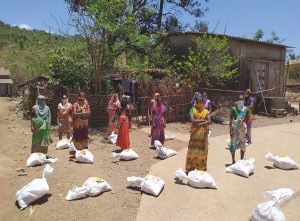

Distribution of food parcels to women in rural areas during the pandemic.
Last year, during the first wave of the pandemic, the club ran a project worth nearly two million dollars to distribute ten million meals to the starving and homeless people who were severely affected by the country’s long lockdown.
Half of these funds were donated by the members, their families and friends.
Members are passionate about helping the local community in the areas of education, underprivileged, subsidised health facilities for the poor, and improving living conditions for the rural population.
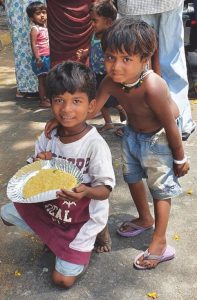

Food distribution to two street children during the lockdown
Camaraderie is a very important feature. Members gathered for two meetings and at least one community event each month before the pandemic.
All Indian festivals, and there are a few of them, are usually celebrated with great joy every year.
Due to the ongoing pandemic, there are no physical meetings, but the Zoom meetings are well attended to listen to speakers from all over the world.
In addition, the members have held virtual events, such as an illusion show, a talent show and workshops. Indians are big foodies. Every month, delicious food baskets made their way to the homes of all members.
If I were to describe the essence of the Rotary Club of Queen’s Necklace, Mumbai, it would be that it is a club that embodies service as a way of life.
Sneha Pathak (RC Queen’s Necklace, Mumbai)
Tradition-conscious and always on time
Rotary Japan has 88,310 members in 2237 clubs in 34 districts (April 2021). Of these, 6265 members are female, about 7%. The reason for the small number could be that there are only a few female executives in Japan.
Japanese Rotarians are typically senior executives or managers. The median age is 60 years. And once they’ve joined Rotary, few leave. Many have a long Rotary history.
Numerous clubs hold a regular one-hour meeting where they have lunch and listen to a table speech. And typically Japanese: the members are always very punctual!
They consider the community to be important and therefore sometimes hold evening meetings where they have more time.
I think that many Japanese members are good at maintaining traditions, but they are not good at changing or they are happy with the current situation.
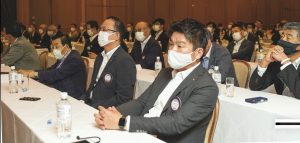

Avoid infections: The meetings currently take place in a frontal seating arrangement and without a meal. Afterwards, packed lunches are distributed
I think they understand that membership needs to be increased, but it’s more important for them to include someone who understands Rotary’s philosophy and community than just increasing the number of members.
The Rotary Club of Yokohama (around 200 members) holds regular meetings in a prestigious hotel.
Before Covid-19, members met at the round table and enjoyed a meal at the hotel. Now they hold their meetings in school style to avoid infections. No meals are provided. Instead, packed lunches are distributed after the regular meeting. It’s best to eat while talking at the same table.
One of the projects we are doing in Japan is the Yoneyama Memorial Scholarship. Yoneyama is the name of the person who establishes a Rotary Club in Japan.
This project is funded by all Japanese Rotarians and awards scholarships each year to approximately 900 foreign students studying in Japan.
The aim is to promote excellent international students who will play an active role in the international community in the future and form a bridge between their home countries and Japan.
To date, we have supported approximately 22,000 students from 129 countries and territories around the world. For regional reasons, most of them are Asian students, but 44 German students have also been supported so far.
Kyoko Nozaki has been editor of the Japanese Rotary magazine ‘Rotary no Tomo’ since 2016
Lonely leader in polio initiatives
Rotary’s history in Brazil began in 1923 with the founding of the Rotary Club of Rio de Janeiro.
Today, with 31 Rotary districts, the country has 2,426 Rotary clubs and 51,945 Rotarians.
Since then, Brazil has hosted three Rotary International conventions: in the cities of Rio de Janeiro (1948) and São Paulo (1981 and 2015).
Rotary International has had three Brazilian presidents: Armando de Arruda Pereira (1940/41), Ernesto Imbassahy de Mello (1975/76), and Paulo Viriato Corrêa da Costa (1990/91), whose Preserve Planet Earth programme inspired the emergence of the Foundation’s new environmental focus.
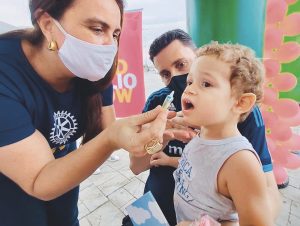

Children are vaccinated against polio in the federal state of Acre
According to the territorial extent of Brazil and its diverse economic, social and cultural characteristics, the clubs of the country have a wide variety of profiles: businessmen, freelancers, teachers and pensioners.
The number of members in Brazil is growing with the number of women, who now make up about 30 percent of Brazilian Rotarians.
One of Rotary’s hallmarks in Brazil is its youth clubs, with 754 Rotaract clubs and 649 Interact clubs with 9,029 and 16,120 members, respectively.
The Rotary family in Brazil is developing important initiatives to help Brazilian communities overcome the severe social inequalities that still characterize the country.
Many of these projects, including those funded by Global Grants, focus on disease prevention and treatment.
These projects include donating equipment to public hospitals, blood donation campaigns, and lending wheelchairs to people who can’t afford them.
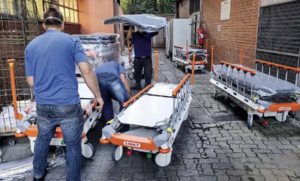

With the support of Global Grants, Rotarians donate equipment to public hospitals.
Other typical projects include book donation campaigns, tree planting, beach and river clean-ups, and the Rotary Youth Leadership Awards.
Since the beginning of the pandemic, Brazilian clubs have been working hard to distribute masks, conduct free testing in nursing homes, and deliver equipment to intensive care units — in addition to providing food and hygiene items to people in need.
The fight against polio is a special chapter in this story. Since the 1980s, Rotary has partnered with Brazil’s Ministry of Health in the fight against polio.
In the past, among other things, funds were donated for the purchase of vaccines. The last polio case in Brazil occurred in
1989, but Rotarians continue to volunteer at the annual National Immunisation Days.
This commitment is reflected in the World Polio Days (WPD) hosted by Rotary International. Since 2016, Brazil has been top of the global ranking of WPD initiatives.
Nuno Virgílio Neto (honorary member of the Rotary Club of Rio de Janeiro) is a journalist and since 2016, has been editor of the magazine Rotary Brasil.
- This article was published in the September issue of Rotary Magazin for Germany and Austria








